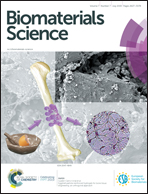Biodegradable organosilica magnetic micelles for magnetically targeted MRI and GSH-triggered tumor chemotherapy†
Abstract
Recently, block copolymer micelles have attracted widespread attention due to their controlled biodegradability and excellent loading capability. Unfortunately, the poor in vivo stability and low delivery efficiency of drug-loaded micelles greatly hampered their biomedical applications. Herein, we develop a new kind of biodegradable magnetite/doxorubicin (Fe3O4/DOX) co-loaded PEGylated organosilica micelles (designated as FDPOMs) with both high circulating stability and smart GSH-triggered biodegradability for magnetically targeted magnetic resonance imaging (MRI) and tumor chemotherapy. The FDPOMs are prepared by the self-assembly of biodegradable polycaprolactone-block-poly(glutamic acid) (PCL-b-PGA), a chemotherapeutic DOX drug and Fe3O4 nanoparticles in an oil/water system, subsequent organosilica cross-linking with 3-mercaptopropyltrimethoxysilane (MPTMS) molecules and surface PEGylation. The resultant FDPOMs exhibit excellent dispersity and stability in biological media, remarkable T2-weighted MR imaging capability, unique GSH-responsive release behavior and selective toxicity to tumor cells. The in vivo experiments show that the FDPOMs not only have improved MR tumor imaging capability, but also exhibit high anti-tumor efficacy due to the strong magnetic targeting ability under an external magnetic field. Consequently, the FDPOMs are promising candidates for magnetically targeted MR imaging and imaging-guided tumor chemotherapy.



 Please wait while we load your content...
Please wait while we load your content...